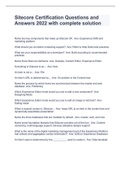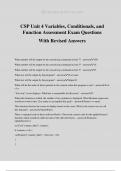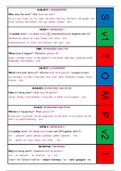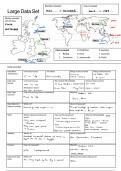Introduction: What is Comp Sci?
Computer Science (CS) is the study of:
Computer software
Algorithms, abstractions and efficiency
Theoretical foundation for computation
Learn the principles of computation, how to make machines perform complex
tasks, problem solving
Problem Solving
1. Understand the problem
2. Plan how to solve the problem (algorithm, break it up, what assumptions
can be made)
3. Carry out your plan (write the program i.e. implement the algorithm)
4. Assess the result (does it solve the problem & is it correct in all cases?)
5. Describe what you have learned
6. Document the solution (comments in the program/report for users)
Algorithms
Algorithm is a set of steps to accomplish a task
o Repeatable
o Have a predictable outcome
o Can be executed by different people
Elements of an algorithm
o Sequence – each step is followed by another step
o Selection – a choice is made
o Iteration – steps may be repeated
Programs
Program is a set of instructions given to a computer, corresponding to an
algorithm to solve a problem
Takes input, processes data, sends computed data back to real world
(output)
Each time a program is executed, results can be different
Python is a general purpose interpreted programming language
Programs stored in text files, written in IDEs
Instructions executed by Python Interpreter
o Run one instruction at a time
o Executes instructions then prompts user for the next
o Used for testing code snippets
Programs must be saved as .py to store permanently
, © Thomas Kabalin
Basics of Programming
Python Syntax
print(“Hello Word”)
Print is the name of the function (common task that can be reused)
“Hello Word” is the argument or value sent to the function
Statements are on separate lines & python is case sensitive
# is used for comments
o Used for description of each function
o Used for non-obvious parts of code
Include the following comment in each program
# what the program does
# author of program
# date
Errors
Syntax errors are when your program does not conform to the structure
required
Logic errors are when your program runs but does not do what is expected
Escape Sequences
Escape sequences are special characters that cannot be represented easily in
the program
\a - bell (beep)
\b – backspace
\n – newline
\t – tab
\’ – single quote
\” – double quote
\\ - \ character
Numeric Data Types
Integers
o Whole numbers with no fractional part
Floating point number
o Number with fractional part
o Stores only an approximation to a real number
o Limit to precision of number
Literals are actual data values written into a program
Integer Expressions
+ (plus), - (minus), / (divide), * (times), % (mod), // (integer division), ** (a to the
power b)
Integer result is given when both operands are integers (except for divide)
Modulus is also known as integer remainer
, © Thomas Kabalin
Identifiers
How things are named e.g. print (reserved for program)
Must start with _ or letter, and optionally followed by more letters, digits or
_
Python style: hello_world
Variables
Sections of memory where data can be stored
Most have names (identifiers)
Defined by assigning an initial value (automatically assigned data type):
a_value = 5
Can assign other variables to variable (b = a + 5)
Advanced Print Statements
To print a series of values:
print(“the values are”, x, y, z)
To change / remove the line ending (usually \n): end=ending
print(x, y, z, end=ending)
To change the separator character between items (usually a space):
sep=sepchr
print(x, y, z, sep=sepchr)
End & sep must come at the end of the print statement (order does not matter)
Input
Stores text string in variable:
<variable> = input(<prompt>)
Always gives a string – must be converted
eval() converts string to number (as either floating point or integer
depending on input)
Can use int() or float() if you know data type
Concatenation symbol is ‘+’ (does not have a separator – just concatenates)
Numerical Syntax
a+=3 (means a=a+3)
a-=3
a*=3
a/=3
Conversion (or casting) is when type is converted to another
Implicit conversions
o If there is a type mismatch, the narrower range value is promoted
up
o Cannot automatically convert down
Explicit conversions
o Typecast methods convert to another type (int, float)
, © Thomas Kabalin
o math.ceil, math.floor, round(number, [decimal places]) give
more control over floating-point numbers
Math Module
Modules are collections of useful functions
To use a module:
import math
To use a function:
math.sqrt(a)
Can also use the following to avoid prefix:
from math import <specific function>
from math import *
Formatting Numbers
print("The answer is: %.1f" % NumToDisplay)
Can add total width before . (%5.1f)
Terminology
Comment
o A part of the code (starting after a # symbol) that is ignored by
python and it intended to help a human reader
Function
o A named sequence of instructions that perform a collective purpose
(e.g. print)
o Items passed into a function (inside the brackets) are called
arguments or parameters
Identifier
o A word, consisting of letters, numbers and _ characters, used to
name functions and variables
Variable
o A container for data (e.g., strings, integers and floating-point
numbers), named using the rules for identifiers
String literal, numeric literal
o Fixed character sequences or numbers used directly (e.g., “Hello”,
3.15)
o Can be further broken down into floating point literal and integer
literal
Expression
o An arithmetic expression combining variables, numeric literals, and
arithmetic operators (e.g, +, -, etc)
Syntax
o The fundamental rules of a programming language










